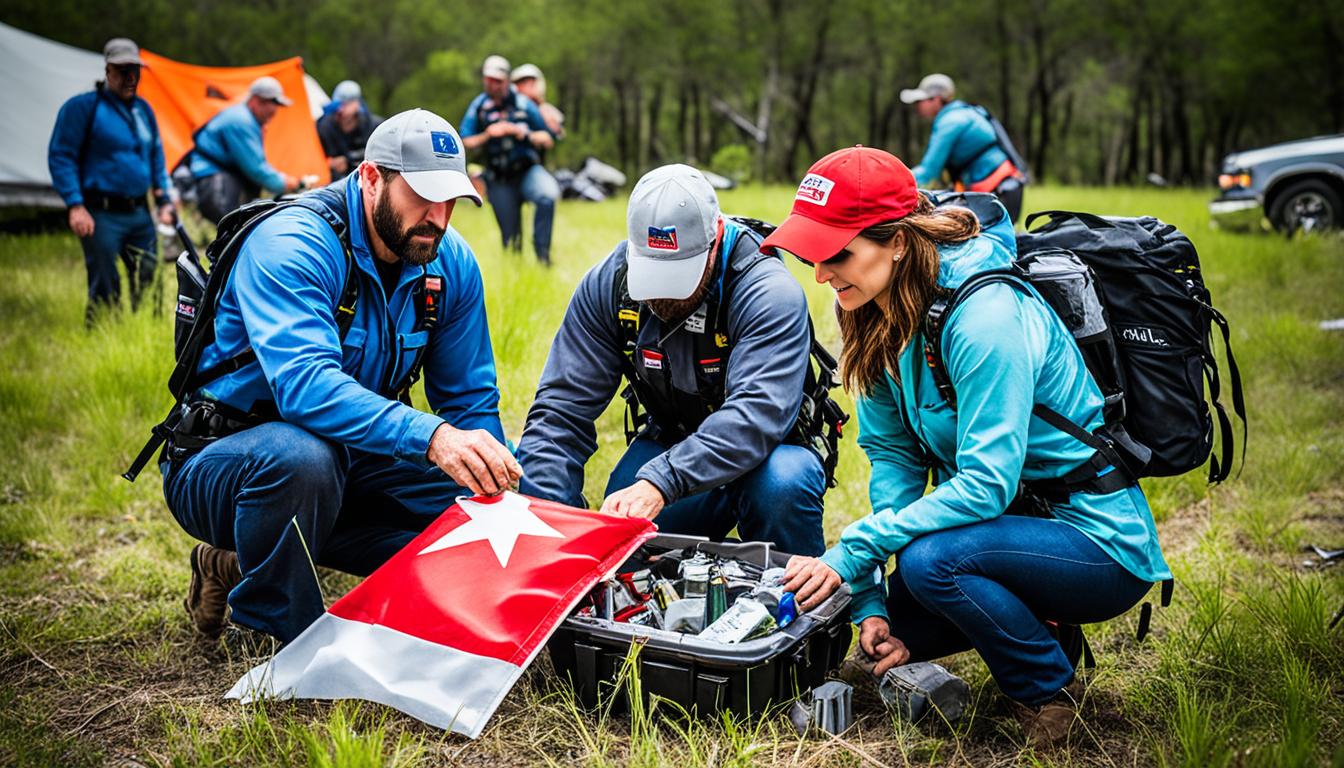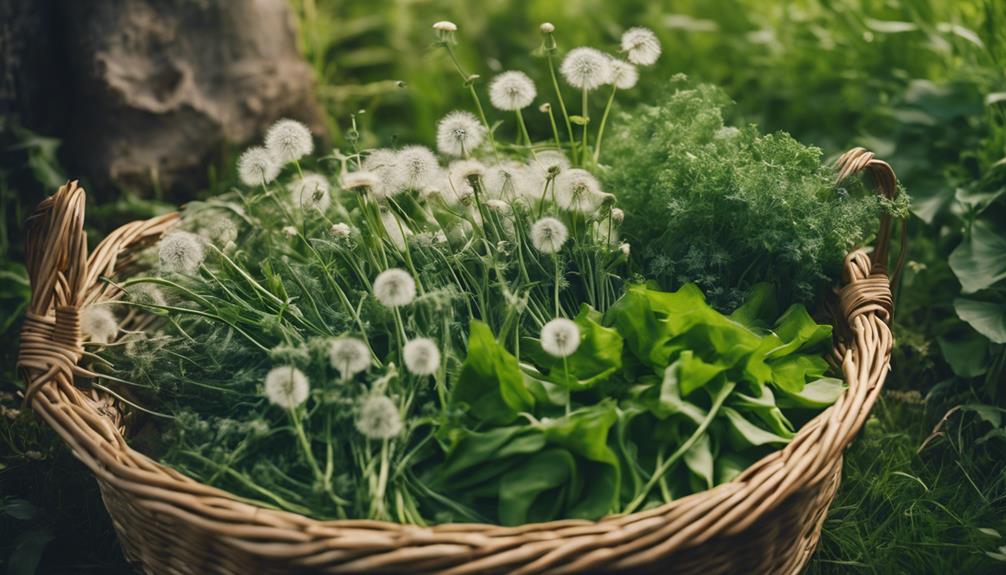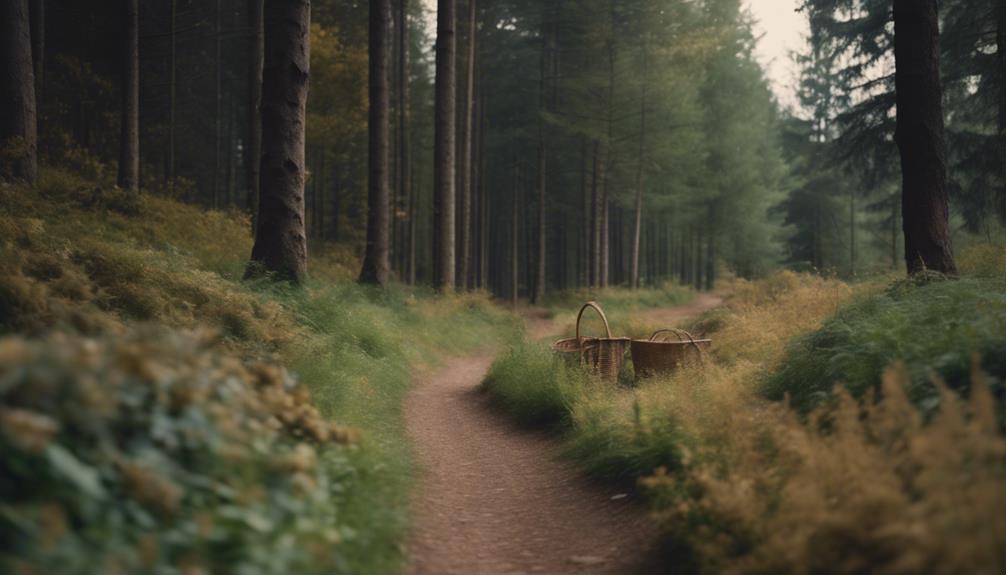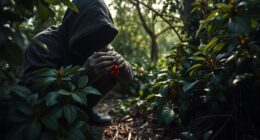To immerse yourself in the world of foraging, begin by mastering plant identification basics to distinguish between edible and harmful ones. Equip yourself with sharp tools to harvest plants without damage and only take what you need. Understand seasonal variations for ideal foraging experiences. Prioritize safety with appropriate clothing and knowledge of poisonous plants. Preserve foraged foods correctly to prevent spoilage. Carry essential tools like a quality knife and field guide. Seek expert advice for advanced techniques. Explore the world of foraging to enjoy a bounty of wild flavors and nutrients. Further insights await as you delve into the nuances of each step.
Key Takeaways
- Research edible plants in your area for safe foraging.
- Use field guides or apps for plant identification.
- Harvest responsibly, leaving some for wildlife and future growth.
- Practice proper storage techniques to maintain freshness.
- Follow safety measures like wearing appropriate clothing and carrying a first aid kit.
Foraging Fundamentals
To excel in foraging, mastering the fundamentals is essential. When venturing into the world of wild foods, proper plant identification is pivotal. Knowing how to distinguish between edible plants and potentially harmful ones guarantees a safe foraging experience. Safety precautions should always be a top priority, such as wearing appropriate clothing, using tools correctly, and being aware of environmental hazards.
Before heading out to gather wild foods, take the time to familiarize yourself with the plants in your area. Learn to recognize common edible species and understand their characteristics.
It's also important to respect the environment by following sustainable foraging practices, seeking permission on private land, and adhering to regulations to protect natural habitats.
Identifying Edible Plants

To successfully identify edible plants while foraging, it's important to understand plant recognition basics like leaf shapes, colors, and growth habits.
Safety precautions are essential when foraging, so be sure to thoroughly research any plant before considering it for consumption.
Edible plant identification is a skill that can be honed through field guides, apps, workshops, and guided tours for a safe and enjoyable foraging experience.
Plant Recognition Basics
Studying field guides, attending workshops, and practicing plant identification in different environments are essential steps in mastering plant recognition basics for identifying edible plants.
To become adept at distinguishing wild plants fit for consumption, follow these tips:
- Focus on Key Features: Pay attention to leaf characteristics such as shape, color, texture, and growth patterns to differentiate between edible plants and toxic ones.
- Detail-Oriented Approach: Examine flowers, fruits, stems, and overall structures of plants to accurately identify edible species in the wild.
- Utilize Tools: Enhance your plant recognition skills by using mnemonic devices, plant ID apps, and online resources to aid in distinguishing between various plant species.
- Hands-On Experience: Develop a sharp eye for plant identification through practical experience, guided foraging trips, and interacting with seasoned foragers in your area.
Safety Precautions Foraging
Enhance your foraging safety by cross-referencing plant identification from multiple reliable sources to minimize the risk of consuming toxic plants.
When out in the wild foraging for plants, it's essential to be cautious and well-informed. Carry a field guide specific to your region to accurately identify edible plants and steer clear of potential hazards.
Additionally, attending workshops or classes on plant identification can boost your skills and confidence in foraging safely. In this digital age, take advantage of smartphone apps like iNaturalist or PlantSnap for real-time plant identification assistance during your foraging adventures.
Remember, when in doubt about a plant's edibility, seek guidance from experienced foragers or local botanical experts before sampling it.
By taking these safety precautions seriously, you can enjoy the rewarding experience of foraging for wild plants while minimizing the risks associated with consuming unknown species.
Stay informed, stay cautious, and happy foraging!
Edible Plant Identification
Boost your foraging skills by mastering the identification of edible plants through studying key features like leaves, flowers, fruits, and growth patterns.
When it comes to identifying edible plants, here are four essential tips to keep in mind:
- Use Field Guides: Carry reliable field guides that focus on edible plants and mushrooms to assist you in accurate identification.
- Leverage Technology: Take advantage of apps and online resources dedicated to plant identification to enhance your foraging experience.
- Prioritize Accuracy: Understanding the importance of precise plant identification is vital to avoid mistakenly consuming toxic plants.
- Look for Distinguishing Features: Pay attention to unique characteristics that differentiate edible plants from non-edible ones, such as specific leaf shapes or fruit colors.
Harvesting Techniques

To effectively harvest food while foraging, make sure you use sharp, clean tools like scissors or knives to prevent plant damage. Always aim to cut plants at the base or pick fruits gently to avoid harming the plant itself. Remember, it's essential to harvest only what you need, leaving some for wildlife and future growth to maintain the ecosystem's balance. Once you've gathered your wild greens or fruits, proper storage is vital to keep them fresh and prevent spoilage, ensuring you can enjoy your foraged treasures for longer.
Harvesting Techniques Table
| Harvesting Technique | Description |
|---|---|
| Cutting at the base | Use scissors or knives to cut plants at their base carefully. This method helps the plant recover and regrow. |
| Gentle fruit picking | When harvesting fruits, gently pluck them to avoid damaging the plant or tree. This method ensures continued fruit production. |
| Leave some behind | Always leave some of the harvested food for wildlife and to support the plant's future growth, ensuring sustainability. |
Seasonal Foraging Tips

When considering seasonal foraging tips, it's important to understand the best times of year to harvest specific wild foods for peak freshness and nutritional value. Here are some key tips to help you make the most of each season:
- Spring: This season is perfect for foraging wild greens like nettles and ramps. These greens are packed with vitamins and minerals, making them a nutritious addition to your meals.
- Summer: Summer brings a bounty of berries such as blackberries and raspberries. These sweet and juicy fruits are ideal for making jams, pies, or enjoying fresh off the bush.
- Fall: As autumn rolls in, you'll find an abundance of nuts like acorns and chestnuts. These nuts are great for roasting or snacking, offering a delicious and satisfying treat.
- Winter: In the winter months, forage for winter greens like chickweed and wild garlic. These greens are rich in antioxidants and nutrients, providing a healthy boost during the colder seasons.
Understanding the seasonal availability of these wild foods will enhance your foraging experience and culinary creations. By knowing when specific plants, mushrooms, and berries are at their peak, you’ll be able to gather ingredients at their most flavorful and nutritious. Additionally, adapting to the unique challenges each season presents will help you strategize your outings and ensure sustainable harvesting practices. For example, wintertime foraging tips and tricks such as identifying cold-hardy plants or recognizing edible tree bark can turn even the colder months into fruitful foraging opportunities. Foraging cold-season edible plants such as wintercress, chickweed, or miner’s lettuce can provide vital nourishment when many other resources seem scarce. Learning to identify and utilize these hardy greens not only contributes to your seasonal culinary creations but also fosters a deeper connection with nature’s rhythms. Remember, responsible harvesting ensures that these plants will continue to thrive for future foragers.
Foraging Safety Measures

Before heading out to forage, make sure you have the necessary safety gear essentials. This includes items like a first aid kit and proper clothing for the environment.
Additionally, it's important to familiarize yourself with identifying poisonous plants to avoid any potential risks while foraging.
Safety Gear Essentials
Carrying essential safety gear is important for protecting yourself while foraging for food. Here are four safety gear essentials to keep you safe while exploring nature:
- First Aid Kit:
Always have a well-equipped first aid kit with you. It should include bandages, antiseptic wipes, tweezers, and any necessary medications to handle minor injuries.
- Plant Identification Field Guide:
A reliable guide for mushroom identification and plant recognition is essential. It helps in distinguishing between edible and poisonous mushrooms, ensuring you stay safe while foraging.
- Charged Phone:
Keep your phone fully charged for emergencies. In case of any mishaps, having a working phone can be a lifesaver.
- Protective Clothing:
Wear appropriate attire such as long sleeves, pants, sturdy shoes, and gloves. This attire safeguards you against scratches, insect bites, and contact with toxic plants.
Poisonous Plant Identification
To safeguard your safety while foraging, being able to identify poisonous plants is an essential skill that can protect you from potential health hazards.
Accidental ingestion of toxic plants can lead to serious consequences, making it vital to learn how to differentiate between safe and harmful vegetation.
Some poisonous plants bear a striking resemblance to edible ones, underscoring the significance of accurate identification.
Utilizing field guides, apps, or seeking advice from experts can assist you in correctly identifying poisonous plants in your foraging areas.
Developing a keen eye for the distinctive features of toxic plants, such as specific leaf shapes or color patterns, is critical for ensuring your safety while exploring nature for food.
Remember, thorough knowledge of poisonous plant identification is a fundamental aspect of responsible foraging, helping you enjoy the bounty of the outdoors without risking your well-being.
Stay vigilant and informed to make the most of your foraging experiences.
Sustainable Foraging Practices

Implementing sustainable foraging practices is essential for maintaining the health of ecosystems and ensuring the long-term availability of wild foods. To help you understand the importance of sustainable foraging, here are some key points to keep in mind:
- Harvest Responsibly: Avoid over-harvesting wild plants to allow for regrowth and to sustain wildlife populations.
- Respect Regulations: Always follow local laws and landowner permissions to forage ethically and legally.
- Minimize Impact: Take steps to reduce your environmental footprint while foraging to preserve the natural habitat.
- Learn and Identify: Properly identify plants, understand their growth cycles, and adopt sustainable harvesting techniques to protect wild food sources.
Processing and Preserving Wild Foods

Properly cleaning and removing any dirt or debris from foraged foods is vital for ensuring their safety and quality. When it comes to processing and preserving wild foods, there are various techniques you can use to extend their shelf life and enjoy them for longer periods. Consider methods like blanching, dehydrating, or making jams and jellies to preserve the flavors of the wild foods you've gathered. It's also important to follow food safety guidelines to prevent spoilage and maintain the quality of the preserved wild foods. To help you grasp these concepts better, here's a breakdown of some processing techniques and food safety guidelines you can employ:
| Processing Techniques | Food Safety Guidelines |
|---|---|
| Blanching | Properly store in airtight containers |
| Dehydrating | Vacuum-seal for freshness |
| Making Jams and Jellies | Prevent contamination |
| Freezing | Check for spoilage regularly |
| Pickling and Fermenting | Label with dates |
Foraging Tools and Equipment

When starting a foraging expedition, make sure you have essential tools such as a quality knife, gloves, a basket or bag for collecting, and a field guide for plant identification. Here are some essential items to enhance your foraging experience:
- Field Guide: A handy reference to help you identify various plants and determine if they're safe to eat.
- Foraging Equipment: Equip yourself with tools like a digging tool, pruning shears, and a magnifying glass to aid in harvesting and examining plants.
- Plant Identification App: Use technology to your advantage by utilizing a plant identification app for accurate plant recognition while foraging.
- Organized Backpack: Consider investing in a foraging backpack with compartments to keep your tools organized and easily accessible during your foraging trips.
Having the right tools and equipment can make your foraging outings safer, more efficient, and ultimately more rewarding. Make sure to pack these items before heading out to explore the bounties of nature.
Expert Foraging Advice

Enhancing your foraging skills requires seeking guidance from experienced foragers to learn proper plant identification techniques. These experts can help you develop a keen eye for distinguishing between toxic look-alikes and safe edible species, ensuring you stay safe on your foraging journey.
Safety and accuracy should always be a priority to avoid potential risks associated with misidentifying plants, especially when it comes to delicate items like wild mushrooms. Continuous learning and practice are essential for honing your skills over time, so don't hesitate to reach out to those with experience in your local area.
Utilize resources such as field guides and online platforms to access expert tips on foraging responsibly. Remember, the wisdom shared by seasoned foragers can be invaluable in enriching your foraging experiences and enhancing your knowledge of the natural world.
Take advantage of their advice to make the most of your foraging adventures.
Enjoying the Fruits of Foraging

Exploring the bountiful rewards of foraging includes discovering and savoring a variety of delicious wild fruits that offer both flavor and nutrition. When it comes to enjoying the fruits of your foraging efforts, here are some tips to make the most of your wild fruit finds:
- Diverse Flavors: Foraging provides access to a range of wild fruits like blackberries, elderberries, and mulberries, each offering a unique taste experience.
- Nutritional Benefits: Wild fruits aren't just delicious but also packed with essential vitamins, minerals, and antioxidants, making them a valuable addition to your diet.
- Culinary Versatility: Transform your foraged wild fruits such as raspberries and wild apples into delectable treats like jams, pies, or simply enjoy them fresh for a burst of natural flavor.
- Sustainable Harvesting: Uphold the future abundance of wild fruits by practicing sustainable foraging techniques that support environmental balance and preserve this natural food source.
Frequently Asked Questions
How Do Beginners Do Forage?
To begin foraging, start by learning from experienced foragers. Build confidence by starting with easy-to-identify wild edibles. Always carry a field guide for plant identification. Try small amounts of new foods first for safety.
How Do You Start Food Foraging?
To start food foraging, research local edible plants, join foraging groups, and use guides for identification. Get permission for private property foraging. Be ethical by leaving enough plants. Remember, the first step is always the hardest!
How to Learn How to Forage?
To learn how to forage, join local classes, workshops, or guided tours. Utilize online resources, field guides, and apps. Consider apprenticing with a seasoned forager. Engaging with these methods will enhance your knowledge and skills in foraging.
What Is the Number One Rule of Foraging?
When foraging, the number one rule is to always be certain of the plant you're harvesting. Misidentifying plants can lead to serious health issues. Stay safe by properly identifying wild foods before consuming them.
Conclusion
Now that you've mastered the art of foraging, it's time to put your skills to the test and impress your friends with your newfound knowledge of wild edibles.
Remember, the world is your grocery store, so go out there and explore nature's pantry. Just be sure to double-check your plant IDs and always put safety first.
Happy foraging!










